Below is a Blog entry written by fellow hobbyist and our good friend- Frank Parrella. Frank is a passionate collector who has been disturbed by recent Online sales in which dolls of questionable authenticity have sold for above market values. We hope that this article is read with the intention of informing the collector community that due diligence be taken when it comes to buying rare and unusual bobbing head dolls. There are many hybrid dolls being sold as original. We are not suggesting that the seller is doing this intentionally, but we are recommending that buyer's must do their homework.
*********************************************************************************************************************************
THE NHL MINIATURE
NODDER SERIES:
The Remake,
“The More Authentic
Remake”,
and
The Real Mini
by
Frank Parrella
Over the past several months there has been a feeding frenzy associated with the rare New York Rangers NHL Miniature nodder. Three dolls have sold in the $500 to $900 range. All were remakes or repaints, not the REAL doll. In particular, two of these sales have raised concerns that should be communicated to the collector community. Therefore it is time to set the record straight on repaints in order to keep the hobby honest for the benefit of collectors at all levels.
In this article I will present the historical background of the NHL Miniature Nodder Series, describe the appeal and condition of the dolls, document what most likely contributed to the rise of the several mini repaints, identify the repaints known to exist among hobby collectors today, summarize recent sales activity related to the New York Rangers mini repaint and, out of concern for the hobby, provide caution for both hobby novices and advanced collectors should mini repaints appear in the future on auction sites.
The Background
The miniature series was produced during the 1961-63 time period in Japan and consists of six team dolls. There are actually seven original dolls in the set because the Toronto Maple Leafs doll was produced with its correct chest decal (the Maple Leaf) and, in error, with the Detroit Red Wings chest decal as well. The dolls which are around four and three quarters inches tall and stand on a square base mirror their standard size counterparts—a set of six teams dolls each approximately 61/2” tall--manufactured during the same time period. The team uniforms of the miniature set, often referred to as minis, possess a richness of color that makes them both beautiful and desirable to collect by both nodder hobby and hockey memorabilia collectors. The six team mini set and the Toronto error doll are pictured below. Note the doll to the far right. It is the REAL New York Rangers mini and much different than any of its repainted clones.
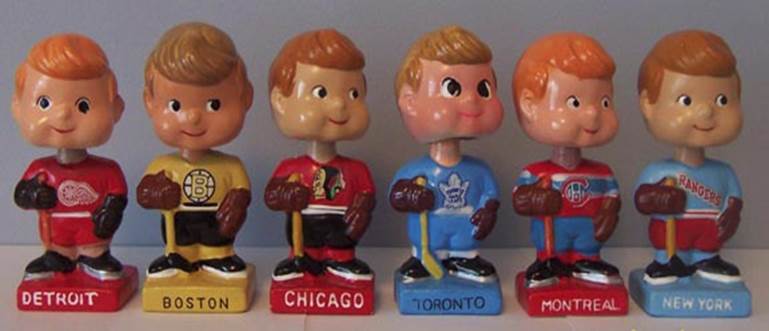
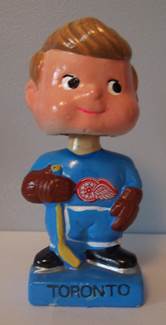
CONDITION
Being a collector for 10 years now I have primarily concentrated on collecting baseball nodders. My team of preference is the New York Yankees and I know that Lou Criscione of Inside the Park Collectibles (ITPC) is shouting “Go Yanks” as he reads and posts this blog article. I have also branched out into non-sports dolls which have an appeal all of their own to advanced collectors, especially the political ones. In addition, I have asked Joe Marasco, a good friend and nodder restoration expert, to create what I call “hybrid” dolls. These creations are “one of one” items that portray baseball nodders that did not exist and are not authentic parts of any baseball series. These hybrids have been detailed in previous blogs on the ITPC website. As my hobby interests have expanded I became attracted to the several hockey series through Joe as he is also a collector as well as a restorer and has the most extensive collection of vintage hockey nodders in existence. The link to Joe’s homepage is listed in the credits at the end of this article. As I continued collecting hockey dolls I began to realize that they have more than an appeal: they are fascinating and have an attraction that just grows on the collector as he or she continues to add dolls from any of the several series that were produced in the 1960s and 1970s. The NHL Miniature Set has just that attraction. The set consists of seven so there is an ease of collection associated with the set (most are plentiful) with the exception of the REAL New York Rangers mini doll which is extremely rare. The condition of these dolls ranges from very nice to downright poor. Some have real spooky eyes and others have faces that are partially finished without paint and/or the shellac/varnish used to add shine to the flat paint used in their production. Others are painted in such a sloppy manner that it is hard to distinguish hockey stick from skate and others have entire areas of the body that were not finished with shellac/varnish. Their base decals were stenciled and oft times were of poor quality and not aligned with the base. Even though they have mold, paint and production flaws (obviously there was no quality control with items that were sold at prices that ranged from under one dollar to a couple of dollars) their outright appeal far outweighs the flaws. They are cute, appealing, simplistic little guys that just grow on you as you collect and display them.
THE FINDS
For the first twenty five years of their existence these minis were virtually unknown to hockey collectors and the hobby as a whole. Any team example was considered rare and commanded value in the hundreds of dollars. Then near the end of the decade of the 1980s all this changed remarkably. Tim Hunter documents in his book, entitled Bobbing Head Dolls 1960-2000, the several waves of “finds” that produced thousands of “mint in box” Toronto (regular and error), Montreal, Detroit, Chicago and Boston examples. What remains an unanswered mystery is the fact that the New York Rangers example did not show up in quantity. As a matter of fact hobby experts have reported that there might be fewer than 50 of these dolls known to exist in collections. We can spend the next fifty years speculating on why this anomaly occurred. Was production nearing the end of the run? Had sales not met expectations? Was production skewed to the other five traditional teams? Was it the luck of the draw that the New York dolls were scheduled for production last? Witness the 1952 Topps Baseball Card series. The “high numbers”, or last series for that season, as they are referred to were produced in lesser quantities because production of the Football Series had begun. The highly valued Mickey Mantle card is in this “high numbers” series.
Fortunately he was double printed in a short print run. But what happened to all the cards in that series. Many were returned from vendors to Topps because they did not sell. And what did Topps do? Sell some of the returned product to Canadian outlets and then dispose of the remainder in Long Island Sound. Being a New Yorker, and knowing that New Yorkers have to do everything really big, it is hard to believe that a New York team was shunned when the NHL Miniature series was produced. We could go on and on. In any event and by circumstance we have a situation where one doll in a six team set has become a rare commodity. As soon as we start climbing that rarity scale the hobby reacts by increasing the item’s value not in linear fashion but in exponential fashion. This is way of the world and the law of supply and demand. It is what it is and we must accept that as fact.
f
The Appearance of Repainted Minis
In response to both the “finds” of the late 1980’s and the rarity of the New York Rangers mini doll an artist from Indiana using the initials KDT, sometime in the early 1990s, not only created a New York Rangers mini doll but he went steps further. From a number of Toronto and Detroit dolls he created two New York Rangers mini variations, a Detroit and a Toronto variation. Speculation is that the rarity of the New York Rangers mini doll drove this effort. These repainted New York Rangers mini dolls afforded hockey collectors a less expensive alternative to completing their six team sets until they were able to find the REAL New York Rangers mini doll if the opportunity ever arose. The work of this artist was very good. His New York Rangers mini variations are presented below on either side of the REAL doll (center image).
At first glance the hockey collector will note that the hair color, jersey and pants colors, and chest and base decals on the two variations differ from the REAL doll and the waist area divider is different on the variation with the white jersey. The artist’s attempt at replicating the decals was very good considering the level of technology available during the time period when these repaints were produced.
As previously mentioned the artist’s work extended to two other known teams as well. The Detroit and Toronto variations are presented below along side of each of their original counterpart. The original mini is on the left in each picture set. As can be observed the Detroit doll kept the original hair color.
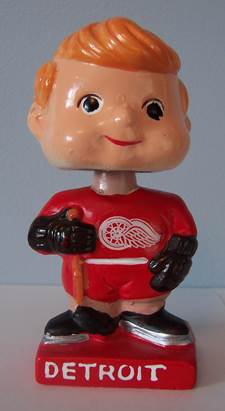
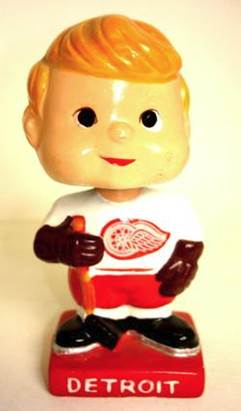
While in the case of the Toronto doll the artist used the same black hair color that was used on the two New York Rangers mini variations.
Knowledge of these repaints has prompted me to ask Joe Marasco to create for me a Johnstown Jets mini repaint, a Toronto Maple Leafs mini repaint and a New York Rangers mini repaint. The Johnstown team last played in Johnstown, Pennsylvania in the North American Hockey League in the 1970’s and subsequently folded in 1977. The full sized original Johnstown doll (image on the left) and the mini repaint or hybrid that Joe created are
pictured below. In this example Joe opted to use the tan or light brown hair color on the mini repaint rather than the black hair color used on the original full sized doll.
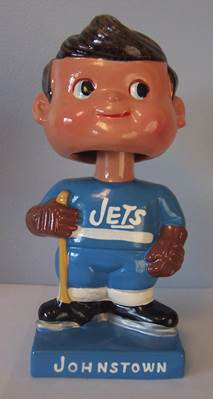
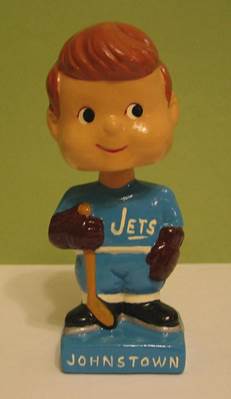
The images presented below compare the Toronto Maples Leafs mini repaint that Joe created for me (the image on the left) to the mini repaint that the Indiana artist created after the “finds”. In this example the tan or light brown hair was used rather than the black hair used in the KDT example. Please note that the blue uniform color on Joe’s creation more closely matches the uniform color of the original Toronto Maple Leafs mini. Also note that there is no waist divider line below the Maple Leaf chest decal on the doll Joe created for me.
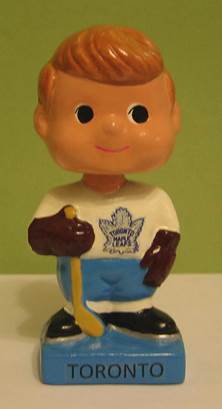
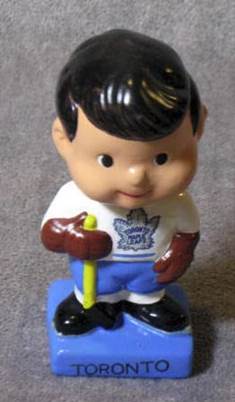
The images presented below compare the New York Rangers mini repaint that Joe created (doll on the left) to the REAL New York Rangers mini. The colors and decals on the repaint have been replicated as closely as possible to the original 1960s doll. However please remember one thing, regardless of how closely this replication is, this mini repaint is just a repaint and not the REAL doll. And, as you can readily see, it more closely resembles the REAL doll than the two New York Rangers mini variations that were made by the Indiana artist in the 1990s.
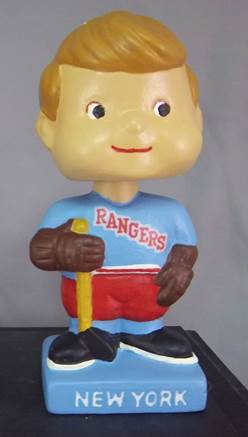
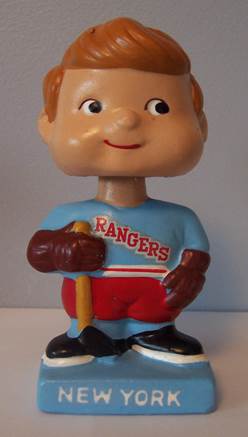
RECENT SALES ACTIVITY
Feeding frenzies for the New York Rangers NHL Miniature nodder remake over the past several months on both a private auction site and EBAY have prompted me to write this article. It is ironic that three of these dolls have appeared for sale since January of this year. On its own accord the doll that appeared in these recent auctions does not show up very often. It was created in the early 1990’s and has basically gone underground for some time and now has gained the status tag of “rare”. This is fine. However it is NOT the rare New York Rangers mini doll that was produced in short quantity in the 1960s in Japan. I repeat—it is NOT that DOLL. One auction site where the doll sold described the doll accurately as a repaint. And that is just what it is. The other site listed two such dolls in May of this year. These were remakes also. One seller, after being notified by hobby collectors, admitted that his item might be a repaint but did not really know, did not change the description on the auction site, and let the auction go to completion. The other seller described the doll as a ”rare” 1962 production item and did not change the description after being notified. He also let the auction go to completion. Granted both of these sellers initially had limited knowledge of the origin of their individual dolls. They both, after being notified that their items were repaints, did not amend their auction descriptions with truthful information. But when it came time to collect the rather large auction prices (from auction winners who may have perceived that they had secured the original New York Rangers mini) gladly did so and paid EBAY its commission on their auction lots. When the host site (EBAY) was notified it also did nothing to correct this injustice. One would not expect EBAY to react. Firstly, it is a corporate enterprise seeking success in profit and secondly, it does not have the expertise to adequately assess and intervene in such matters. As a matter of fact EBAY prefers that any policing be done by the hobby not by EBAY. Consequently both dolls sold for in excess of $800. Now remember this is a doll that is a remake and is worth around $100 at best. A knowledgeable auction site lists its value at between $150 and $250. In my humble opinion that is assigning too much value to a doll that is a fake, plain and simple. In any event, $150 or $250, whatever, is nowhere near the $1500+ base value of the real doll. And this lesser value doll should in no way be portrayed to the hobby as representing the original doll and then sell for a value greater than the remake is worth. The doll is a very adequate remake that can be added to any collection but it is not the real deal. Since around 2010 the real deal has been sold on various auction sites for prices that range from just under $3000 to just over $4100. The most recent of these was in July of 2011 where one sold for over $3600 in another feeding frenzy on a credible auction site. Maybe the advanced collector can justify paying over twice the book value for a rare original mini to complete the set of six. That is after all the prerogative of the purchaser. But advanced or not, no collector can justify spending between $500 and $900 for a repaint, remake or “out and out” fake. Call it what you may. This does not bode well for both sellers and collectors involved with the nodder hobby.
Caution for the Future
The information presented in this article is intended to caution prospective collectors should the New York Rangers mini repaint appear on auction sites in the future. It is perfectly acceptable to bid reasonably on the repainted version and, hopefully, secure it for one’s collection. But always err on the side of caution. Feel free to use the pictures and descriptions in this article to guide yourself against sellers who claim they don’t really know anything about what they are selling on the one hand but are greedy enough to see how much money their item will bring in auction. Be alert and constantly watchful of the auction sites for you may be surprised to find another copy of
“the more authentic remake”
for sale in the near future.
*********************************************************************************************************************************
Credits
Credit for selected pictures and factual information is attributed to the following sources:
Joe Marasco’s website entitled,
“Hockey Bobbing Heads”
· The link to his homepage is
http://www.frontiernet.net/~hknodder/Index.shtml
· The link to his Hockey Mini Series page is
http://www.frontiernet.net/~hknodder/MiniDolls.html
Lou Criscione’s publication entitled,
Warman’s Bobbing Head Field Guide, 2005
Lou Criscione’s website entitled,
Inside the Park Collectibles
· The link to his homepage is
http://insidetheparkcollectibles.com/
Tim Hunter’s publication entitled,
Bobbing Head Dolls 1960-2000, 1999